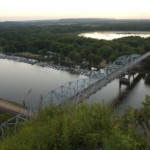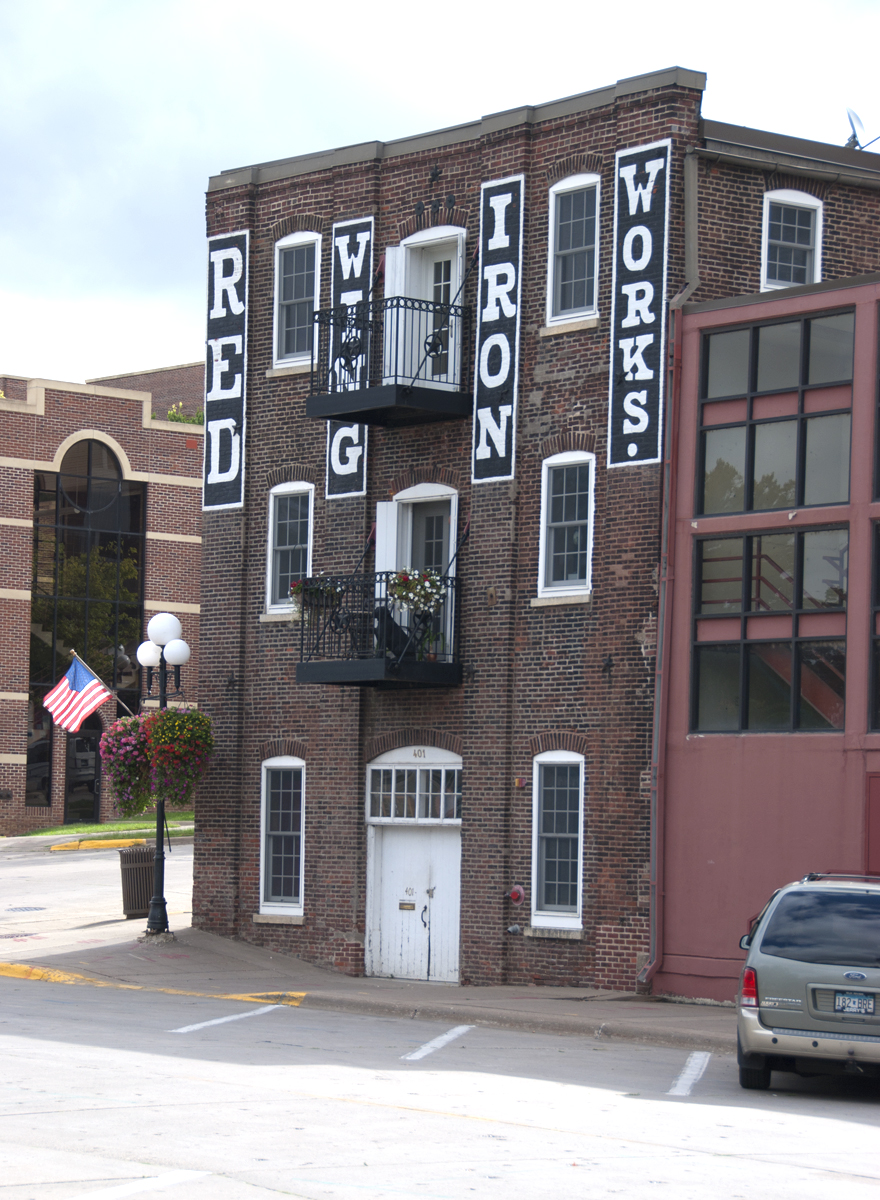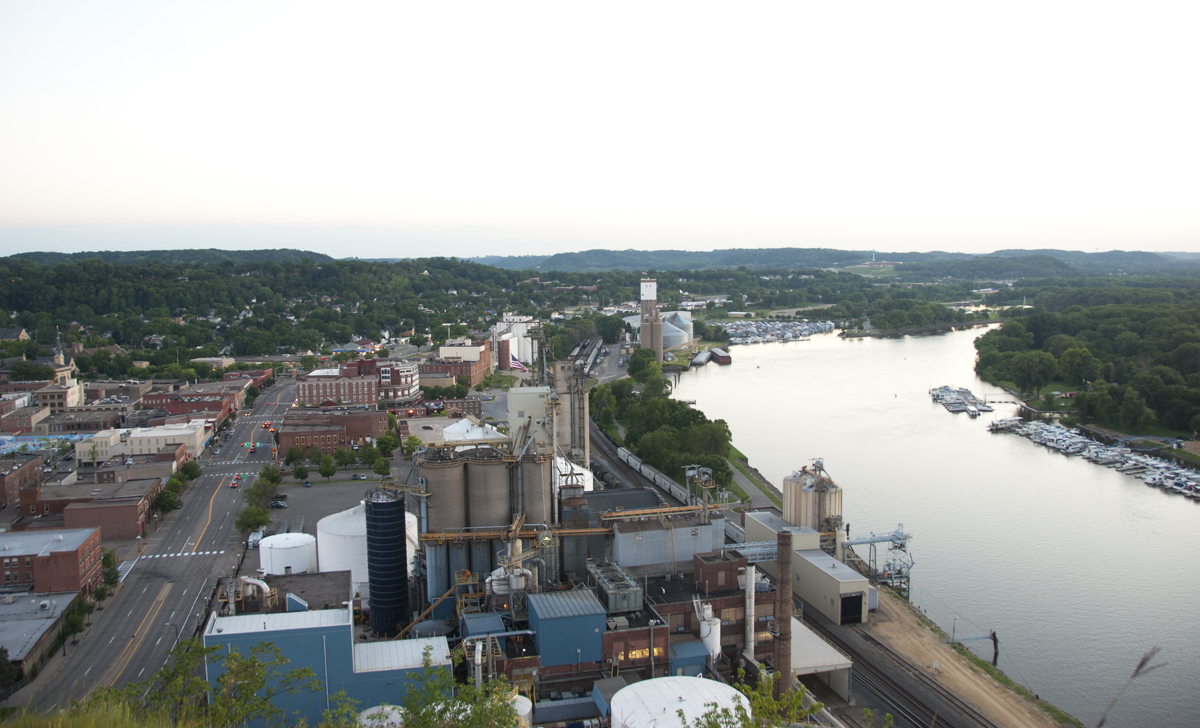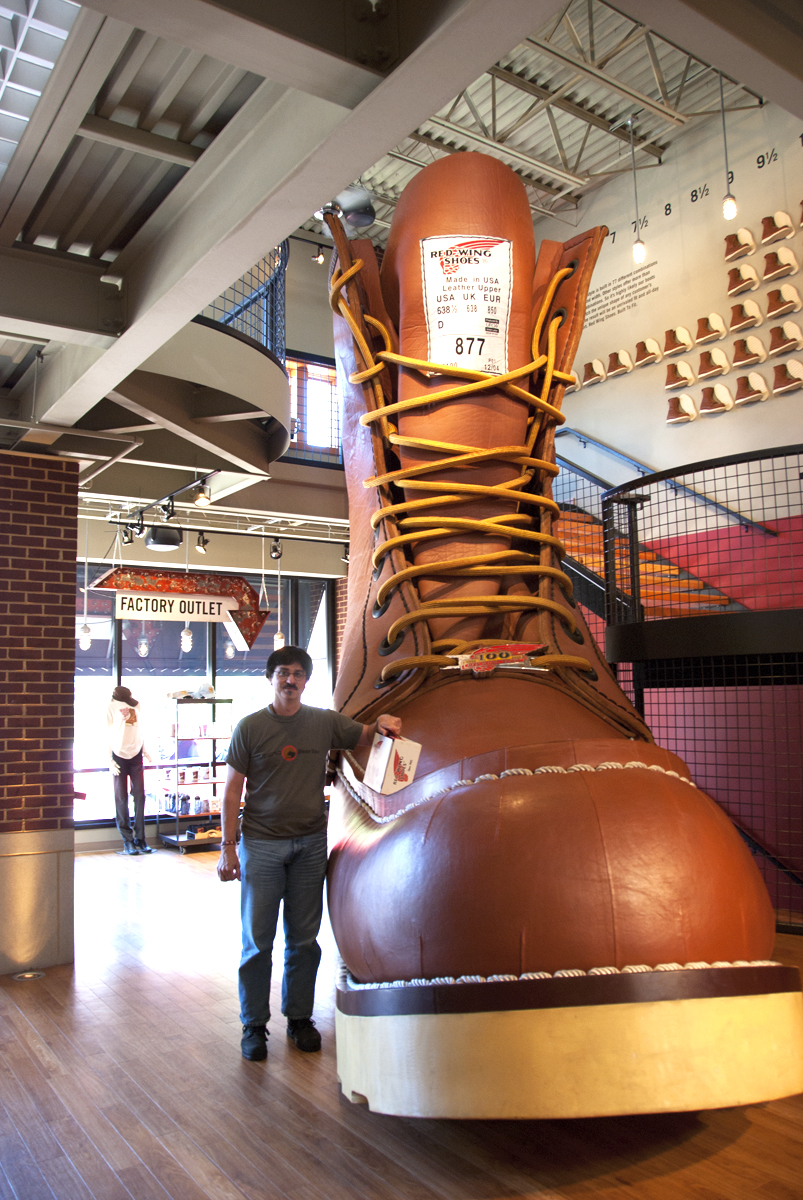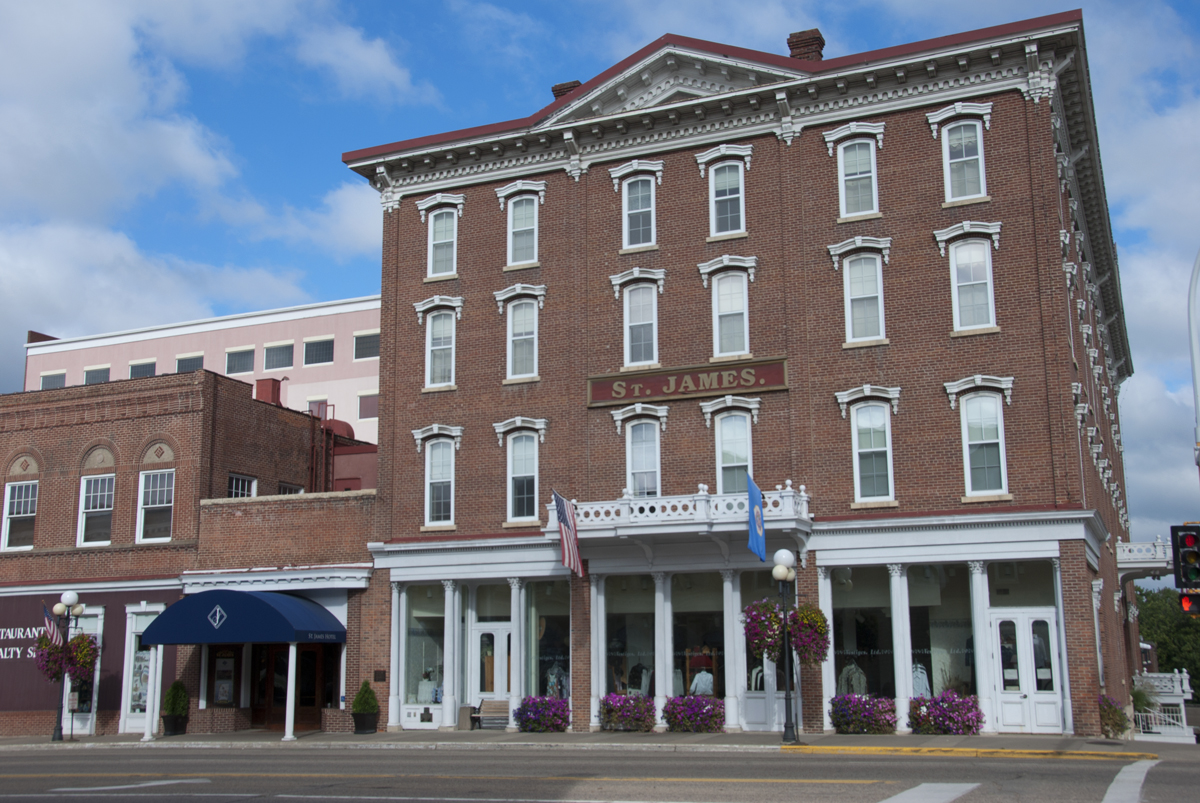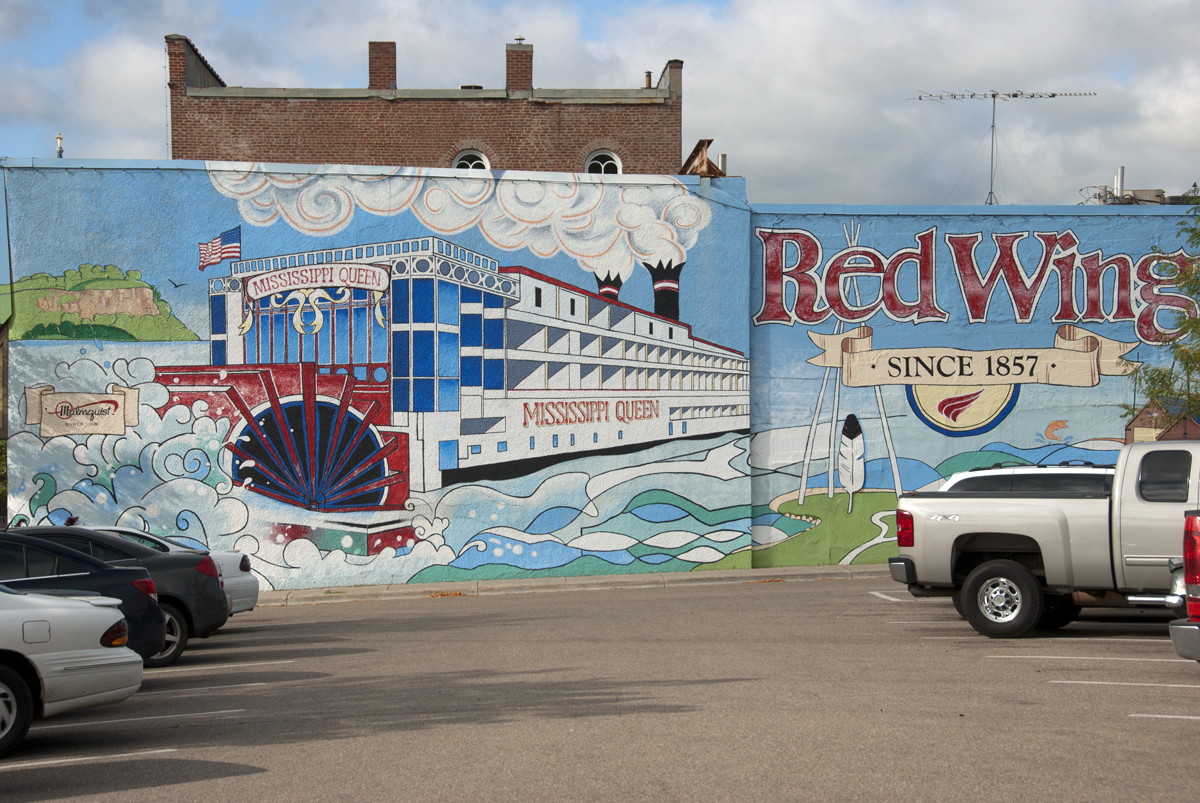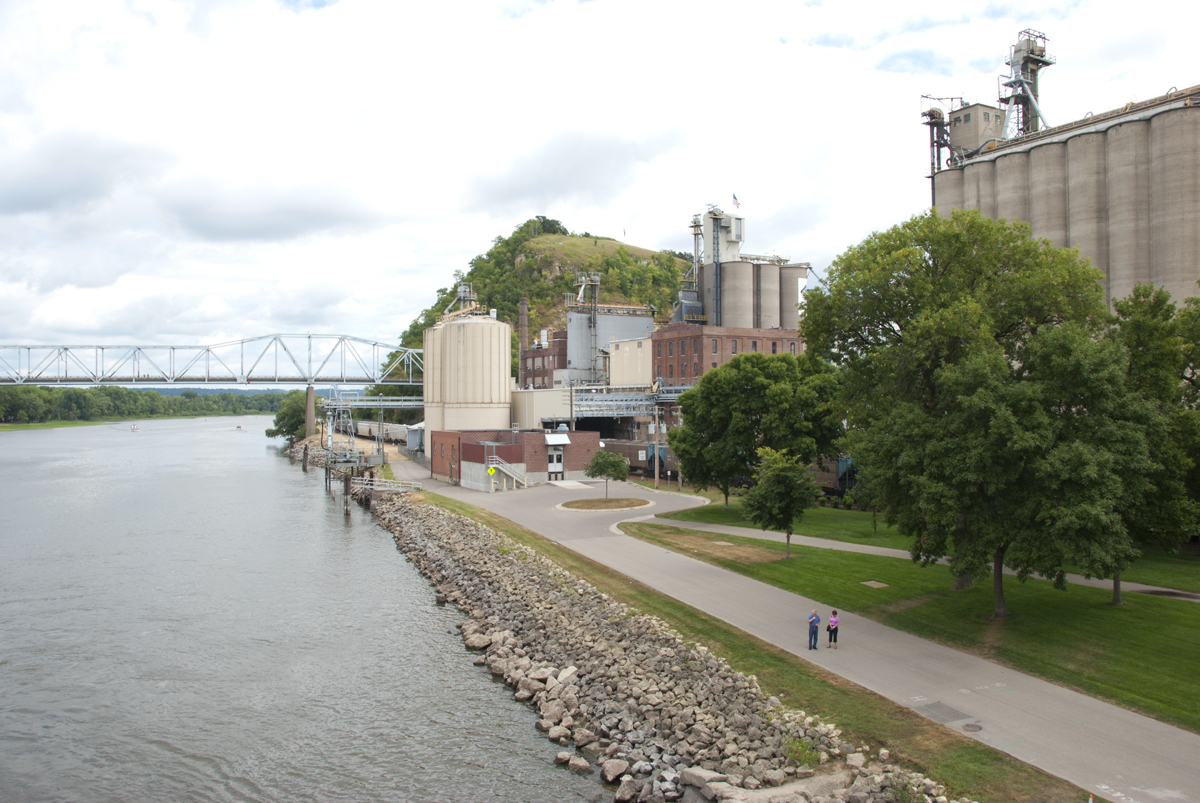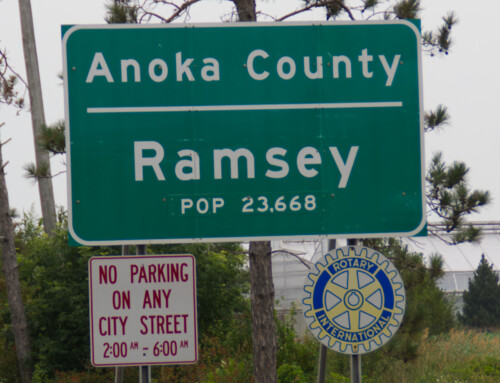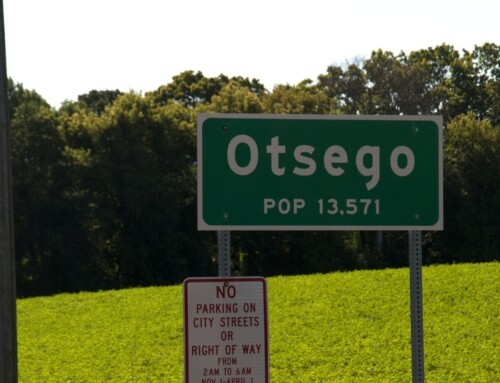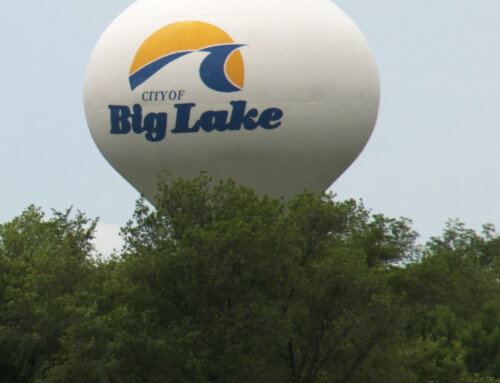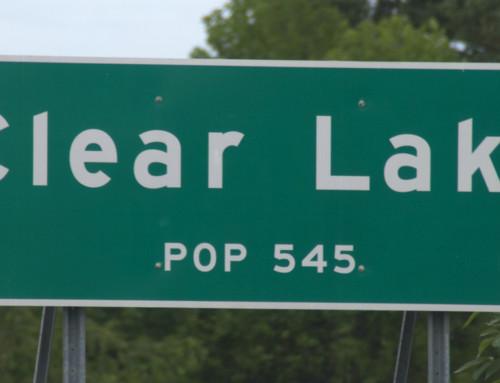Introduction
A popular destination for daytrippers from the Twin Cities, Red Wing is a good place to use as a base to explore the surrounding area; stick around for a few days.
Visitor Information
Get your questions answered at the Red Wing Convention and Visitors Bureau (120 Broad St.; 651.385.5934).
History
Let’s start with the town’s namesake: Red Wing. He was probably born about 1750 and was probably the nephew of Chief Wabasha I, though no one is sure. He was a shaman and a very successful military leader of the Mdewakanton Dakota in the latter part of the 18th century. In Dakota his name was Tatankamani (Walking Buffalo). French explorers, for reasons that are not well documented, called him L’Aile Rouge (Red Wing). He broke from Wabasha’s band, leading a group of 100 who lived near the mouth of the Cannon River. He led an active life in the middle of changing times, chatting with the explorer Zebulon Pike in 1805 and fighting with the British against American interests before switching sides in the middle of the War of 1812. He traveled to Portage des Sioux (Missouri) in 1815 to sign a treaty of friendship with Americans. When he was older, he gave the name Red Wing to his oldest surviving son, Wakute, and called himself Shakea (The Man Who Paints Himself Red). He died March 4, 1829 while hunting.
The land around the Cannon River was not open to legal settlement until 1853, but a few Europeans still found a way to move in. The first to arrive were two families of Swiss missionaries: Samuel and Persis Denton in 1837 and Daniel and Lucy Gavin in 1838. They stayed until 1845, probably converting no one. Another group of Presbyterian missionaries and their families arrived in 1849 when Minnesota became a territory. At that time, Red Wing was home for about 300 Dakota. Among this group of missionaries were Joseph Hancock (b. 1816 in Orford, NH) and his wife Maria Houghton Hancock. Joseph built good relationships with the Dakota and learned their language. In 1850, Maria died during childbirth, and the next year his son died, too. Distraught, he left Red Wing for several years. John Day came from Wisconsin and moved—illegally—into the abandoned mission house, trying to establish a claim on land that still belonged to the Dakota. The Dakota were not amused, so they tore down the house. Day built a new house and the Dakota tore that one down, too. This process repeated itself about a dozen times before Day finally left.
The Dakota ceded the rights to their lands with the 1851 Treaty of Mendota and were removed from Minnesota by the 1860s. With the Dakota gone, Europeans flooded in and reshaped the area. Red Wing was platted in 1853 and became the county seat. Joseph Hancock eventually returned and played a central role in the city’s development, serving as post master and writer of first county history, among other things.
Most early settlers were from the East, but there were also many Scandinavian and German immigrants. Hotels were built to house new arrivals, including an ill Henry David Thoreau who came for a four-day health respite in June 1861. He was trying to recover from tuberculosis but died the next year. While in Red Wing, he climbed Barn Bluff and was so moved he wrote about the river valley: “Too much could not be said for the grandeur and beauty.”
Red Wing counted 1,251 residents in 1860 and over 4,000 just 10 years later. Much of Red Wing’s early growth was fueled by wheat. In 1873, Red Wing had a warehouse that could store one million bushels of the grain; twice that amount shipped from town that year. The wheat trade declined in importance by 1880, but Red Wing had a strong, diversified economy with businesses like shoe manufacturing, sorghum processing, the Red Wing Iron Works (1866-1983), cigar factories (mostly 1870-1920), brewing, brick manufacturing, lumber, and quarrying.
Pottery makers have been mainstays in the local economy for generations. In the early years, local clay was plentiful and was an especially good raw material. The industry began with German immigrant Joseph Pohl in 1861; he later decided that farming was a better fit for him. William Philleo founded a terra cotta business in 1870 and had a nice run. He moved his company to St. Paul in 1880 and renamed it, but some of his former employees stayed in town and founded the Red Wing Stoneware Company. In 1906, the three existing pottery companies merged to form the Red Wing Union Stoneware Company, which produced pottery until 1967. In 1984, the Red Wing Pottery brand was brought back to life.
Red Wing’s economy today is a mix of light manufacturing, healthcare, and tourism; the Red Wing Shoe Company is the largest employer.
Exploring the Area
The standout geological feature in town is a chunk of land that rises 300 feet above the city. Known to the Dakota as He Mni Can (hill, wood, water), Europeans called it Barn Bluff because the general shape reminded them of a barn. You can explore He Mni Can/Barn Bluff Park (500 East Fifth St.; 651.385.3674) via hiking trails that take you past abandoned quarries, next to limestone cliffs, and across goat prairies with great views of the area. You will also find remnants of Webster’s Way, concrete steps to the top that were first built in 1899, rebuilt, then mostly destroyed by highway construction.
Memorial Park (542 E. 7th St.; 651.385.3674) sits atop Sorin’s Bluff and is another place with great views of the area. A few thousand years ago, Barn Bluff and Sorin’s Bluff were islands in a much wider and deeper Mississippi River.
From big views to big shoes. The Red Wing Shoe Museum (315 Main St., 3rd floor; 651.388.6233) houses the World’s Largest Boot, crafted for the company’s 100th anniversary in 2005. The boot is 16 feet tall, 20 feet long, and 7 feet wide, measuring an impressive size 638 ½ D, perfect for that 120-foot tall person in your life.
If you’re interested in the history of boating and the motors that helps propel them, make time to tour the collection at the Red Wing Marine Museum (935 Levee Rd.; 651.442.7661; open Saturdays 1-5 from June-Oct.). The collection emphasizes the inboard motor built by Red Wing Marine but there is also a collection of outboard motors and other river-related items.
The Aliveo Military Museum (321 Bush St.; 651.327.1569) showcases the collection of Bruce Sexton, a 30-year military veteran who served around the world and had a chance to collect some remarkable items: rare bayonets, a Philippine Moro Kris sword, a Zulu shield, and uniforms. The broadest collection of items is from WWII-era Germany and Japan but other places and wars are represented.
The Goodhue County History Center (1166 Oak St.; 651.388.6024) has a wide-ranging collection that traces the history of the region from the earliest inhabitants to today. The collection includes displays on early agriculture and trades (don’t miss the 18th century Lien family lathe), local characters like France Densmore and Eugenia Anderson, the lumber industry, and recent and distant history of the Native American population.
The Pottery Museum of Red Wing (240 Harrison St.) showcases the history of stoneware in Red Wing, with pieces that are functional and artistic (and some very large). Did you know that mason jars were once made of stoneware, not glass? I didn’t. Check out the impressive range of stoneware jars that range in size from minis barely large enough to hold a few tablespoons of salt to the 20 gallon monsters.
Many of the bluffs along the Mississippi River are home to ecosystems with rare plants and animals, like the area preserved at Spring Creek Prairie Scientific & Natural Area (651.259.5800). Within the 146 acres at this site, you’ll find prairie grasses, skinks, and an endangered plant called bladderpod. There are no developed trails, so please watch where you’re walking. The site is north of Red Wing and isn’t as tricky to find as the directions sound. To get there from US Highway 61,
- go south on Tyler Road
- west on Koseck Drive
- south on Old Tyler Road
- south on Red Fox Drive
- west on Wild Turkey Lane;
- at the cul-de-sac, continue on the gravel road to the parking area
Culture & Arts
The Red Wing Arts Association Art Gallery (418 Levee St.; 651.388.7569) maintains an impressive gallery in the old rail depot next to the visitors center.
If you want to sample performing arts, check out the schedule for the Sheldon Theatre (433 W. 3rd St.; 800.899.5759/651.388.8700). The charming renaissance revival building opened in 1904 and still hosts movies and live shows.
Dr. Alexander P. Anderson, inventor of puffed rice and puffed wheat, built an estate and research center on the northern end of town that is now an artist-in-residence program called the Anderson Center at Tower View. Adjacent is the Anderson Park Sculpture Garden (163 Tower View Dr., 651.388.2009), a 15-acre space dotted with large-scale sculptures and a few interpretive signs explaining the different types of ecosystems native to Minnesota.
Fair Trade Books (320 Bush St.; 651.800.2030) has a good collection of works from local and regional writers, plus they host live music regularly.
Sports & Recreation
The Cannon Valley Trail (507.263.0508) is a 20-mile former railroad line converted to a multi-use trail from Cannon Falls to Red Wing that is popular with bicyclists, in-line skaters, hikers, and cross-country skiers. The trail has an elevation change of 115 feet but it is so gradual, you probably won’t notice. The trail is free for hikers but other users must purchase a pass.
The Hay Creek Trail is a six-mile paved bike path connects to the Cannon Valley Trail and will eventually form part of the Goodhue Pioneer State Trail. The trail ends at Dorer Memorial Hardwood Forest—Hay Creek Unit (State Highway 58; trails open May 1–Nov. 1), a day-use recreation area with horse trails.
If you want to bike one of the trails but didn’t bring a bicycle, no worries. You can rent from the St. James Hotel.
For a swim, your best bet is the Colvill Aquatic Center (480 Nymphara Lane; 651.388.9234) and its large pool with waterslides.
For skiing or snowboarding, head to Welch Village Ski and Snowboard Area (26685 County Road 7 Blvd.; 651.258.4567).
Indoor ice skating is available at Bergwall Arena (215 Pioneer Rd.; 651.388.6088) and Prairie Island Arena (370 Guernsey Lane; 651.267.4346). Call for open skating times and fees. Outdoor skating rinks are abundant.
Parks Along the Mississippi River
Red Wing has several riverside parks that would be fine spots to picnic.
- Bay Point Park (1392 Levee Rd.) is next to Boat House Village and the main channel
- Levee Park (432 Levee Rd.) is a small, pleasant riverside park with a memorial to the Sea Wing disaster
- Further from downtown, Colville Park (510 Nymphara Lane) has plenty of places to spread out along the river
Getting on the River
Captain Brian Klawitter (651.307.8326) takes folks on the river from April 1 through November 1 for two-hour eagle-watching tours..
Entertainment and Events
If you are in town on a Wednesday evening between late June and early August, check out a concert at the band shell in Central Park (4th Street at East Street).
One of the best venues for live music is just outside of town at the Music Loft of Hobgoblin Music (920 Highway 19; 651.388.8400). They host events, often once a month, that bring in musicians that lean toward roots/Americana.
Farmers Market
Red Wing hosts a farmers market weekday mornings from mid-May to mid-October (Red Wing City Hall, 315 W. 4th St.), plus a weekly market on Saturday mornings (8a–1p) on Levee Street near the train depot.
Festivals
Red Wing has festivals throughout the year, but two of the best ones are River City Days (800.498.3444) in early August that includes a Venetian boat parade and the Fall Festival of the Arts (800.498.3444), a juried art fair that celebrates local and regional art.
**Red Wing is covered in Road Tripping Along the Great River Road, Vol. 1. Click the link above for more. Disclosure: This website may be compensated for linking to other sites or for sales of products we link to.
Where to Eat and Drink
Falconer Vineyards Winery produces wines from local grapes and good pizza (3572 Old Tyler Rd.; 651.388.8849).
Willow Brooke Vineyard (29212 Orchard Rd.; 651.388.1770) hosts a fun evening of pizza, wine, and music on Wednesday evenings (5-8pm) from mid-May through September.
Enjoy a locally-made beer at the Red Wing Brewery (1411 Old West Main St.; 651.327.2200), where you can also nosh on pizza.
For a light breakfast, head to Hanisch Bakery (410 W. 3rd St.; 651.388.1589) and snack on fresh pastries and coffee.
Get your daily dose of caffeine from Mandy’s Coffee & Café (419 W. 3rd St.; 651.800.2026), where you can also snack on pastries or have a light lunch.
Beloved Stockholm Pie Company operates the Pie Plate Café in Red Wing (2000 Old Main St.; 651.376.8993). Stop in a slice of pie (sweet or savory) or enjoy a wrap or sandwich for lunch.
Bev’s Café (221 Bush St.; 651.388.5227) is a downtown diner that offers heartier, reasonably-priced breakfasts; check out the gritwurst, a house specialty.
Kelly’s Tap House Bar & Grill (1530 Old West Main St.; 651.388.9913) has an impressive selection of craft beer to pair with one of their many bar food options.
Liberty’s Restaurant and Lounge (303 W. 3rd St.; 651.388.8877) is a family-friendly restaurant with a wide-ranging menu of generally well-prepared foods from burgers to tacos to lasagna to walleye, and you can order breakfast all day.
Fresh and delicious Mexican standards are the norm at Fiesta Mexicana (2918 N. Service Dr.; 651.385.8939); their menu includes a nice range of seafood options.
Fill up on delicious smoked meats at Smokin’ Oak Rotisserie & Grill (4243 Highway 61; 651.388.9866).
Staghead Gastropub (219 Bush St.; 651.212.6494) has a creative menu based around ingredients sourced mostly from local producers.
Scarlet Kitchen & Bar (406 Main St.; 651.385.5544) at the St. James Hotel has offers casual dining with a river view. They offer a full breakfast menu; lunch and dinner menus lean toward salads, sandwiches, and light entrées.
Where to Sleep
You’ll find a full range of types of accommodations in Red Wing; the city is especially blessed with nice bed-and-breakfast inns.
Camping
About six miles from town, the Hay Creek Valley Campground (31655 Highway 58 Blvd.; 651.388.3998) has plenty of overnight sites in a scenic valley adjacent to the Hay Creek Unit of Dorer State Forest; overnight sites are mostly in an open field with little shade but are large.
Budget
The only non-chain budget option in town is the Parkway Motel (3425 Highway 61 North; 651.388.8231; WiFi); rooms are in decent shape and clean and come standard with fridge, microwave, coffee, and cable TV.
Bed-and-Breakfast Inns
Don’t be fooled by the imposing limestone Italianate house that is the Moondance Inn (1105 W. 4th St.; 651.388.8145); the interior is welcoming and artful, decorated with French and Italian antiques. The house was essentially gutted after being rescued from neglect, so the rooms are in great shape and equipped with private baths including two-person whirlpool tubs.
The Pratt-Taber Inn (706 W. 4th St.; 651.388.7392) is in an 1874-era house that went through a major overhaul; the four rooms, all with a private bath, have a seasonal theme and are decorated with a nod to the past but not handcuffed by it.
The Round Barn Farm (28650 Wildwood Lane; 651.385.9250) is simply lovely. The house was built just a few years ago but it looks like a 19th century brick farmhouse thanks to generous use of reclaimed materials. The five guest rooms each have a private bath with whirlpool tub and individual climate controls, plus a fireplace, and feather beds with pillowtop mattresses. Don’t forget to check out the namesake round barn, built in 1914 and used primarily for special events.
Moderate and up
The Nichols Inn of Red Wing (1750 US Highway 61; 651.388.6633) is a newer hotel in a commercial district north of downtown with clean, contemporary rooms outfitted with fridge, coffee, and cable TV; some rooms have a microwave.
The Grande Dame of local lodging is the St. James Hotel (406 Main St.; 651.388.2846). This historic hotel was built in 1874-5 and has been a landmark in Red Wing for generations. In 1975, the Red Wing Shoe Company rescued the hotel from oblivion and completed a major overhaul that included building a new tower. No two guest rooms are identical. Each is named for a steamboat and has a handmade Amish quilt. The hotel offers a number of package deals that help make a stay here more affordable.
Getting There
Red Wing is one of the stops on Amtrak’s Empire Builder route. Amtrak uses the neoclassical Red Wing Depot (420 Levee St.) but does not maintain a service window. You can buy your tickets on-line, by phone (800.872.7245), or on the train. Westbound trains depart Red Wing in the evening for destinations along the Mississippi River that include Saint Paul (1 hour, 40 minutes) and St. Cloud (3 hours, 50 minutes) before continuing on to Seattle. Eastbound trains depart Red Wing in the morning and pass through Winona (1 hour, 15 minutes) and La Crosse (1 hour, 45 minutes) before terminating at Chicago (7 hours).
Resources
The local newspaper is the Red Wing Republican Eagle (651.388.2914).
Post Office: 222 West Ave.; 651.388.8637.
Red Wing Public Library: 225 East Ave.; 651.385.3673; WiFi.
Community-supported writing
If you like the content at the Mississippi Valley Traveler, please consider showing your support by making a one-time contribution or by subscribing through Patreon. Book sales don’t fully cover my costs, and I don’t have deep corporate pockets bankrolling my work. I’m a freelance writer bringing you stories about life along the Mississippi River. I need your help to keep this going. Every dollar you contribute makes it possible for me to continue sharing stories about America’s Greatest River!
Red Wing Photographs
©Dean Klinkenberg, 2011,2017
